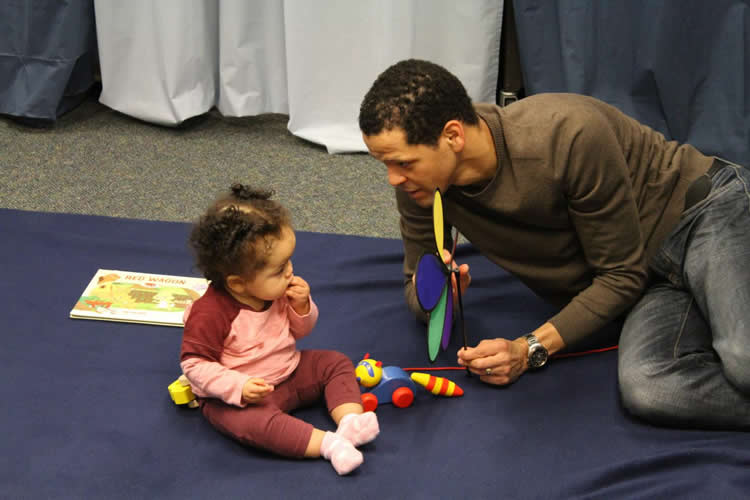Many brain studies show that bilingual adults have more activity in areas associated with executive function, a set of mental abilities that includes problem-solving, shifting attention and other desirable cognitive traits.
Now new findings reveal that this bilingualism-related difference in brain activity is evident as early as 11 months of age, just as babies are on the verge of producing their first words.
“Our results suggest that before they even start talking, babies raised in bilingual households are getting practice at tasks related to executive function,” said Naja Ferjan Ramírez, lead author and a research scientist at the Institute for Learning & Brain Sciences (I-LABS) at the University of Washington.
“This suggests that bilingualism shapes not only language development, but also cognitive development more generally,” she said.
The study also gives evidence that the brains of babies from bilingual families remain more open to learning new language sounds, compared with babies from monolingual families.
The study was published online April 4 in Developmental Science and will appear in an upcoming issue of the journal.
“Monolingual babies show a narrowing in their perception of sounds at about 11 months of age — they no longer discriminate foreign-language sounds they successfully discriminated at 6 months of age,” said co-author Patricia Kuhl, co-director of I-LABS.
“But babies raised listening to two languages seem to stay ‘open’ to the sounds of novel languages longer than their monolingual peers, which is a good and highly adaptive thing for their brains to do,” Kuhl said.
The researchers used magnetoencephalography (MEG), which measures magnetic changes given off by active nerve cells. Unlike other brain-imaging methods, MEG can precisely pinpoint both the timing and location of activity in the brain.
The study is the first to use MEG to do whole-brain analyses comparing activation patterns in response to speech sounds in babies raised in monolingual and bilingual households.
In the experiment, 16 11-month-old babies — 8 from English-only households and 8 from Spanish-English households, and an even mix of demographic factors such as the family’s socioeconomic status — sat in a highchair beneath the helmet-like MEG scanner.
The babies listened to an 18-minute stream of speech sounds, such as “da’s” and “ta’s.” The stream included sounds specific to English or Spanish, and sounds shared by the two languages.

he researchers compared monolingual and bilingual babies’ brain responses to the language sounds.
The most obvious difference they saw was in two brain regions associated with executive function, the prefrontal cortex and orbitofrontal cortex. In these regions, the Spanish-English bilingual babies had stronger brain responses to speech sounds, compared with English-only babies.
The findings align with brain studies in bilingual and monolingual adults, Ferjan Ramírez said. The boost bilingualism gives to executive function areas in the brain could arise from bilinguals needing to switch back and forth between languages, allowing them to routinely practice and improve executive function skills.
Other brain evidence from the study should be a relief for parents wondering if their bilingual baby is learning enough language:
- Bilingual babies displayed neural sensitivity to both English and Spanish sounds, meaning that they were learning both languages.
- Bilingual babies had the same sensitivity to English sounds as the monolingual babies, which suggests that they were learning English at the same rate as the monolingual babies.
Bilingual and Monolingual Baby Brains Differ in Response to Language
“The 11-month-old baby brain is learning whatever language or languages are present in the environment and is equally capable of learning two languages as it is of learning one language,” Ferjan Ramírez said.
“Our results underscore the notion that not only are very young children capable of learning multiple languages, but that early childhood is the optimum time for them to begin,” she said.
Other co-authors of the study are Rey Ramírez, Maggie Clarke and Samu Taulu–all researchers at UW’s I-LABS.
Funding: The National Science Foundation UW LIFE Center funded the research.
Source: Molly McElroy – University of Washington
Image Credit: The image is credited to Institute for Learning & Brain Sciences, UW.
Video Source: The video is credited to I-LABS Tech Support.
Original Research: Abstract for “Speech discrimination in 11-month-old bilingual and monolingual infants: a magnetoencephalography study” by Naja Ferjan Ramírez, Rey R. Ramírez, Maggie Clarke, Samu Taulu and Patricia K. Kuhl in Developmental Science. Published online April 4 2016 doi:10.1111/desc.12427
Abstract
Speech discrimination in 11-month-old bilingual and monolingual infants: a magnetoencephalography study
Language experience shapes infants’ abilities to process speech sounds, with universal phonetic discrimination abilities narrowing in the second half of the first year. Brain measures reveal a corresponding change in neural discrimination as the infant brain becomes selectively sensitive to its native language(s). Whether and how bilingual experience alters the transition to native language specific phonetic discrimination is important both theoretically and from a practical standpoint. Using whole head magnetoencephalography (MEG), we examined brain responses to Spanish and English syllables in Spanish-English bilingual and English monolingual 11-month-old infants. Monolingual infants showed sensitivity to English, while bilingual infants were sensitive to both languages. Neural responses indicate that the dual sensitivity of the bilingual brain is achieved by a slower transition from acoustic to phonetic sound analysis, an adaptive and advantageous response to increased variability in language input. Bilingual neural responses extend into the prefrontal and orbitofrontal cortex, which may be related to their previously described bilingual advantage in executive function skills.
“Speech discrimination in 11-month-old bilingual and monolingual infants: a magnetoencephalography study” by Naja Ferjan Ramírez, Rey R. Ramírez, Maggie Clarke, Samu Taulu and Patricia K. Kuhl in Developmental Science. Published online April 4 2016 doi:10.1111/desc.12427






